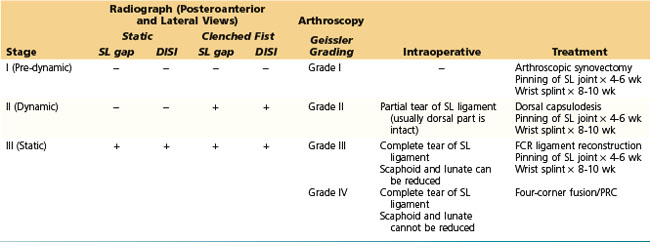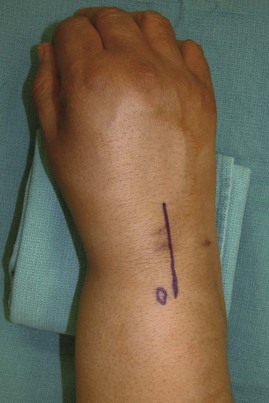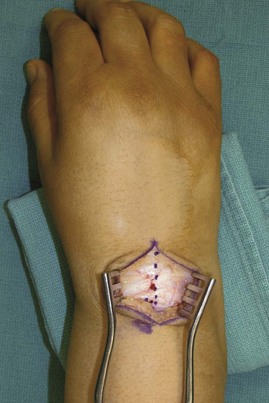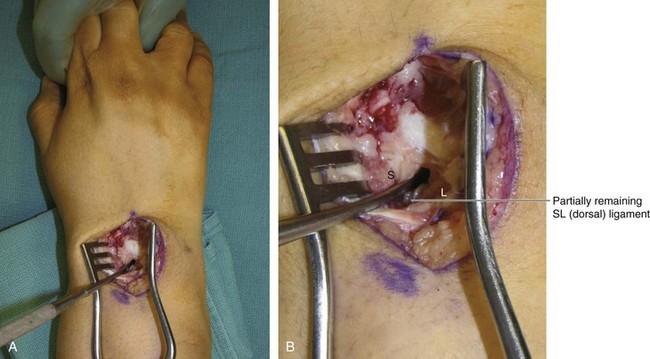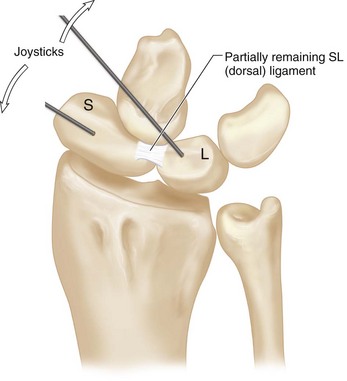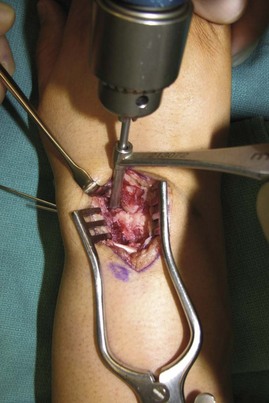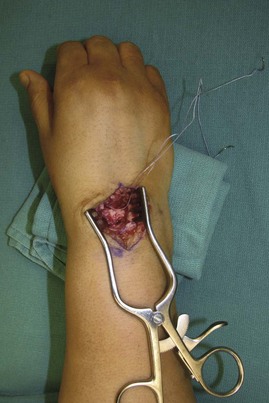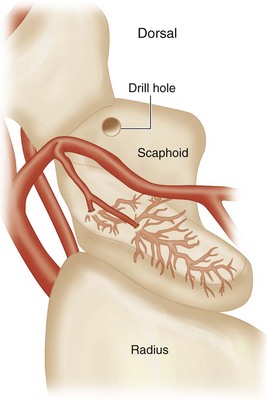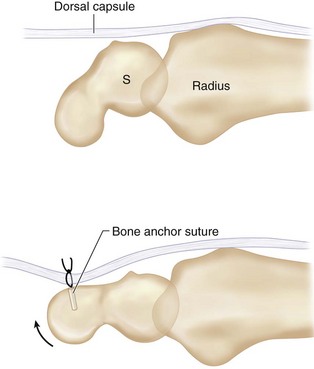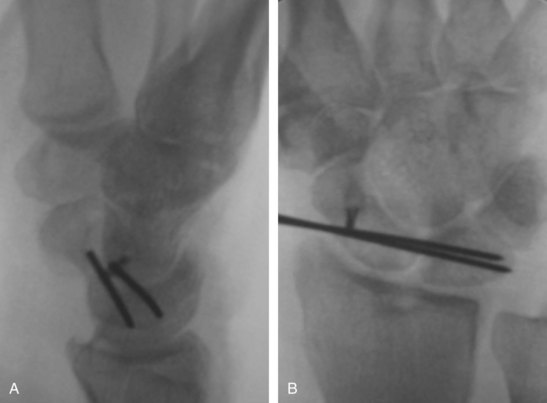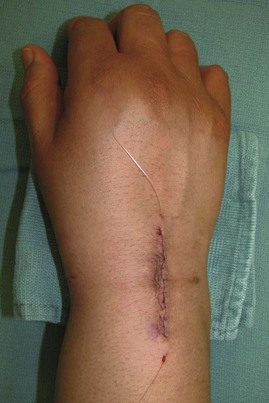Procedure 72 Dorsal Capsulodesis for Scapholunate Instability Using Suture Anchors
![]() See Video 53: Dorsal Capsulodesis for Scapholunate Ligament Injury
See Video 53: Dorsal Capsulodesis for Scapholunate Ligament Injury
Indications
 Static or dynamic dorsal intercalated segmental instability (DISI) deformity is found without a wide scapholunate (SL) gap.
Static or dynamic dorsal intercalated segmental instability (DISI) deformity is found without a wide scapholunate (SL) gap.
 We determine the treatment for SL instability based on clinical presentation, radiographic appearance, and arthroscopic and intraoperative findings. Our current algorithm for selection of appropriate procedure for SL instability is indicated in Table 72-1.
We determine the treatment for SL instability based on clinical presentation, radiographic appearance, and arthroscopic and intraoperative findings. Our current algorithm for selection of appropriate procedure for SL instability is indicated in Table 72-1.
Examination/Imaging
Clinical Examination
 Patients complain of radial-sided wrist pain especially with loading activities, weakness of grip, and swelling, along with discomfort at extremes of wrist extension and radial deviation.
Patients complain of radial-sided wrist pain especially with loading activities, weakness of grip, and swelling, along with discomfort at extremes of wrist extension and radial deviation.
 Tenderness is found in the radial snuffbox or over the SL interval just distal to the Lister tubercle.
Tenderness is found in the radial snuffbox or over the SL interval just distal to the Lister tubercle.
 The following two provocative tests have been described for global assessment of wrist pain. These tests are useful in patients when the history and findings of examination do not match. However, they do not indicate the location or nature of the pathology.
The following two provocative tests have been described for global assessment of wrist pain. These tests are useful in patients when the history and findings of examination do not match. However, they do not indicate the location or nature of the pathology.
 One or more of the following provocative tests may be positive depending on the degree of injury to the SL ligament and integrity of the secondary stabilizers.
One or more of the following provocative tests may be positive depending on the degree of injury to the SL ligament and integrity of the secondary stabilizers.
Imaging
 Stress views, including the clenched-fist view, posteroanterior maximal radial deviation, and posteroanterior maximal ulnar deviation, are useful in the diagnosis of dynamic SL instability.
Stress views, including the clenched-fist view, posteroanterior maximal radial deviation, and posteroanterior maximal ulnar deviation, are useful in the diagnosis of dynamic SL instability.
 Arthroscopic examination has become the standard method of evaluation of interosseous ligamentous injuries. The arthroscopic classification of ligament injuries proposed by Geissler (Table 72-2) is useful in determining treatment options.
Arthroscopic examination has become the standard method of evaluation of interosseous ligamentous injuries. The arthroscopic classification of ligament injuries proposed by Geissler (Table 72-2) is useful in determining treatment options.
Surgical Anatomy
 The SL ligament is a C-shaped structure that connects the dorsal, proximal, and volar surfaces of the scaphoid and lunate. Partial SL ligament tears most often involve only the proximal and volar components of the SL interosseous ligament complex. The dorsal ligament is much stronger than its volar counterpart and may resist substantial traumatic torques without yielding.
The SL ligament is a C-shaped structure that connects the dorsal, proximal, and volar surfaces of the scaphoid and lunate. Partial SL ligament tears most often involve only the proximal and volar components of the SL interosseous ligament complex. The dorsal ligament is much stronger than its volar counterpart and may resist substantial traumatic torques without yielding.
 The normal kinematics of the SL joint is governed by the SL ligament, a primary stabilizer, and by an envelope of surrounding extrinsic ligaments that act as secondary stabilizers, namely the radioscaphocapitate (RSC), the long and short radiolunate (LRL and SRL) ligaments on the volar side, and the dorsal radiocarpal (DRC) and dorsal intercarpal (DIC) ligaments on the dorsal side.
The normal kinematics of the SL joint is governed by the SL ligament, a primary stabilizer, and by an envelope of surrounding extrinsic ligaments that act as secondary stabilizers, namely the radioscaphocapitate (RSC), the long and short radiolunate (LRL and SRL) ligaments on the volar side, and the dorsal radiocarpal (DRC) and dorsal intercarpal (DIC) ligaments on the dorsal side.
 When the scaphoid has lost its connections to the lunate, the role of secondary stabilizers is particularly important. Their failure results in the static carpal malalignment.
When the scaphoid has lost its connections to the lunate, the role of secondary stabilizers is particularly important. Their failure results in the static carpal malalignment.
Exposures
 A 6-cm dorsal longitudinal incision centered over the radiocarpal joint in line with the long finger metacarpal is made (Fig. 72-1). Sharp dissection is carried down to the extensor retinaculum. Skin and subcutaneous tissue flaps are raised on both sides. The third dorsal compartment is identified and does not need to be opened along its entire length. The wrist capsule is opened longitudinally and dissection performed to elevate the second and fourth compartments, such that the second and fourth compartment tendons are maintained within the compartment (Fig. 72-2). This exposes the scaphoid and lunate.
A 6-cm dorsal longitudinal incision centered over the radiocarpal joint in line with the long finger metacarpal is made (Fig. 72-1). Sharp dissection is carried down to the extensor retinaculum. Skin and subcutaneous tissue flaps are raised on both sides. The third dorsal compartment is identified and does not need to be opened along its entire length. The wrist capsule is opened longitudinally and dissection performed to elevate the second and fourth compartments, such that the second and fourth compartment tendons are maintained within the compartment (Fig. 72-2). This exposes the scaphoid and lunate.
 Figure 72-3 shows a Freer elevator within the SL interval demonstrating a partial rupture of the SL dorsal ligament.
Figure 72-3 shows a Freer elevator within the SL interval demonstrating a partial rupture of the SL dorsal ligament.
Procedure
Step 1: Reduction of Scaphoid and Lunate
Step 2: Maintenance of SL Reduction
Step 3: Make a Drill Hole in the Scaphoid, and Insert a Bone Anchor
 Make a drill hole at the most distal part of the scaphoid (Fig. 72-5).
Make a drill hole at the most distal part of the scaphoid (Fig. 72-5).
 A 1.8-mm bone anchor suture (Mitek Mini QuickAnchor or similar) is placed in the drill hole (Fig. 72-6).
A 1.8-mm bone anchor suture (Mitek Mini QuickAnchor or similar) is placed in the drill hole (Fig. 72-6).
Step 4: Secure the Dorsal Capsule to the Scaphoid
Postoperative Care and Expected Outcomes
 Following surgery, the patient is placed in a volar wrist splint for 8 weeks.
Following surgery, the patient is placed in a volar wrist splint for 8 weeks.
 Ten days after the operation, the wound is examined and sutures are removed.
Ten days after the operation, the wound is examined and sutures are removed.
 The K-wires are removed 6 to 8 weeks after the surgery. The K-wires are often cut under the skin to avoid pin tract infection, which is common when the K-wires are left outside the skin for more than 3 weeks.
The K-wires are removed 6 to 8 weeks after the surgery. The K-wires are often cut under the skin to avoid pin tract infection, which is common when the K-wires are left outside the skin for more than 3 weeks.
 Eight weeks after the surgery, the patient is transitioned to a removable volar splint for an additional 4 weeks, and gentle active wrist range of motion commences.
Eight weeks after the surgery, the patient is transitioned to a removable volar splint for an additional 4 weeks, and gentle active wrist range of motion commences.
 Although the wrist’s range of motion decreases about 20%, most patients have significant improvement in pain after this procedure.
Although the wrist’s range of motion decreases about 20%, most patients have significant improvement in pain after this procedure.
Gajendran VK, Peterson B, Slater RRJr, Szabo RM. Long-term outcomes of dorsal intercarpal ligament capsulodesis for chronic scapholunate dissociation. J Hand Surg [Am]. 2007;32:1323-1333.
Moran SL, Cooney WP, Berger RA, Strickland J. Capsulodesis for the treatment of chronic scapholunate instability. J Hand Surg [Am]. 2005;30:16-23.
Wintman BI, Gelberman RH, Katz JN. Dynamic scapholunate instability: results of operative treatment with dorsal capsulodesis. J Hand Surg [Am]. 1995;20:971-979.

